14 peaceful pond walks to discover around Buzzards Bay this winter
There’s something special about ponds – they’re vibrant, reflective pools chirping with species in summer and icy, peaceful havens for people and wildlife in winter. They’re also diverse, ranging from coastal salt ponds along Buzzards Bay’s shores to inland kettle ponds that offer a peek at the region’s glacial past.
Because winter is a particularly beautiful time of year to enjoy ponds, we’ve put together a list of 14 local places where you can take a walk by a pond. When you stop to appreciate the view, remember that all of these ponds are somehow linked to Buzzards Bay: whether through streams, via groundwater, or simply as part of the web of life in our region.
1. Goosewing Beach Preserve (Little Compton)
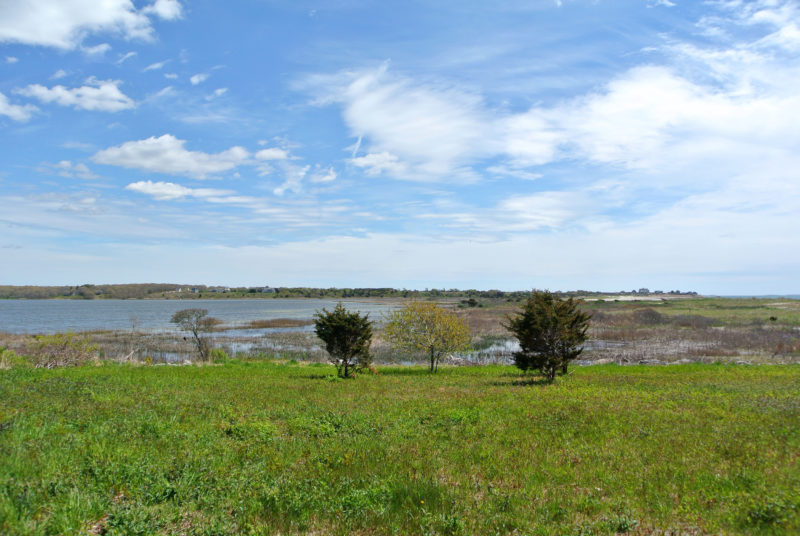
Goosewing Beach Preserve in Little Compton looks out over Quicksand Pond, Buzzards Bay’s largest salt pond.
With a barrier beach system and meadows lined with historic stone walls, the Nature Conservancy’s Goosewing Beach Preserve in Little Compton is one of Rhode Island’s most scenic spots to discover. It’s also home to 390-acre Quicksand Pond, the largest natural salt pond on Buzzards Bay.
In winter, the crowds fade from adjacent South Shore Beach, making it a great time of year to explore the preserve. Walk the meadow trails to take in spectacular views of Quicksand and Tunipus ponds, where migratory birds flock to feed and find shelter.
2. Forge Pond Conservation Area (Westport)
Forge Pond Conservation Area’s namesake pond is owned by the Fall River Water Department, but the trails and parking lot are part of the Westport Land Conservation Trust’s network of protected properties. It’s a popular spot for fishing during warmer months. In winter, the pond shines as a quiet place for people to walk.
There are two trails at Forge Pond: a path that runs along the pond to the Noquochoke River, and a steep trail that climbs the hill overlooking the pond. The pondside trail provides several scenic overlooks where you can stop to peek for wintering birds.
3. Allens Pond Wildlife Sanctuary (Dartmouth)
With 7 miles of hiking trails spanning more than 600 acres of protected beaches, fields, forests, and salt marshes, Mass Audubon’s Allens Pond Wildlife Sanctuary is a destination for those who love to explore wild, diverse habitats. From sandy, windswept shores to working farms along the sanctuary’s edge, Allens Pond’s scenery is among the most spectacular on Buzzards Bay.
The pond itself is a coastal salt pond, and has been recognized as one southern New England’s most significant coastal habitats. More than 300 species of birds have been recorded here, including the rare piping plover, which nests along the beach. In winter, look (and listen!) for ducks and water birds as you walk among the pond’s unspoiled salt marshes.
4. Betty’s Neck (Lakeville)
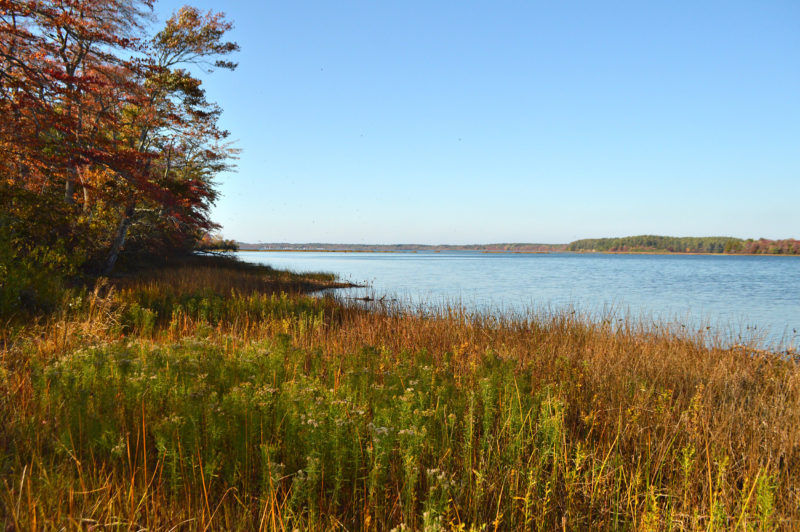
Take in a spectacular view of Assawompset Pond from Betty’s Neck in Lakeville.
Located in the middle of thousands of acres of protected land, Betty’s Neck is one of the few public places where you can access Assawompset Pond: the largest natural body of fresh water in Massachusetts. The ponds in this complex supply public drinking water for nearly a quarter-million people in southeastern Massachusetts, including New Bedford and Acushnet. (Because this land protects clean drinking water, there is no swimming, wading, or paddling allowed at Betty’s Neck.)
With so much preserved land, this area provides important habitats for wildlife, including some rare species. It’s one of the few places in southeastern Massachusetts where bald eagles nest – and winter is a particularly good time to watch for them from the quiet, hilly trails at Betty’s Neck.
5. Tripps Mill (Mattapoisett)
The Coalition’s own Tripps Mill is the site of a former sawmill along Tripps Mill Brook, a small stream that flows to the Mattapoisett River. This historic water-powered sawmill was one of many that serviced the industry in this area.
Today, the remnants of the mill on Tinkham Pond are a scenic point of interest in the expanding Mattapoisett River Reserve. It’s an ideal place to enjoy a walk in the woods any time of year. Want a fun treasure-hunting adventure? Search for the hidden geocache along the pond’s wooded edge.
6. Leonard’s Pond (Rochester)
Take in a lovely view of Leonard’s Pond in Rochester from the shores of two small properties owned by the town of Rochester and the Rochester Land Trust. They’re a perfect destination if you’re looking for a short outdoor stroll or an idyllic waterfront picnic spot.
Leonard’s Pond is a stopover for migrating waterfowl, so look for geese, mergansers, and buffleheads rafting on the pond’s surface in fall, winter, and spring.
7. Washburn Park (Marion)
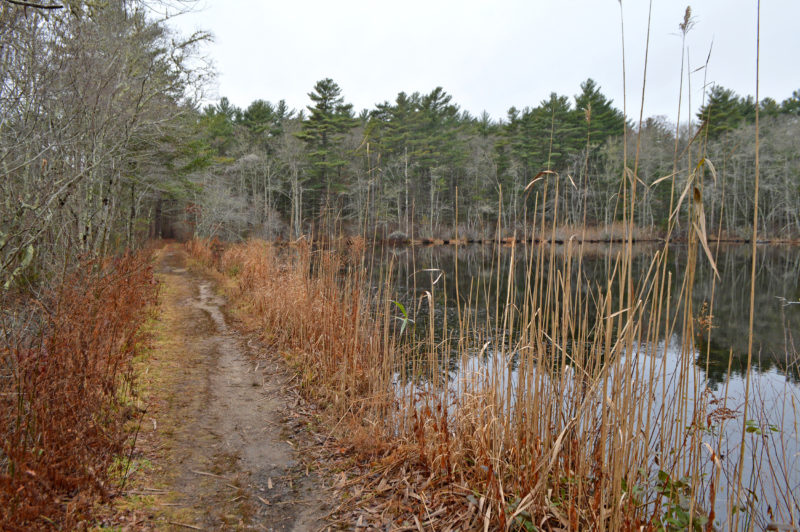
The trail at Washburn Park leads past a secluded pond, providing a place to walk or jog in quiet peace.
If you’ve never ventured into the woods at Marion’s Washburn Park, then you’re in for a surprise! Ponds and wetlands are tucked into the forest, making for beautiful scenery and a magnet for birds. Ducks dabble around the pond throughout the year, and Canada geese crash-land on the pond’s surface during their migrations north in spring and south in fall.
Washburn Park is home to a network of flat, easy trails that vary in length and scenery. You can do a short loop through the woods or take a longer jaunt and enjoy the view.
8. Myles Standish State Forest (Carver/Plymouth)
Myles Standish State Forest is one of the state’s largest and most important protected areas. It’s home to nearly five dozen “kettle ponds”: glacier-created ponds that are fed by groundwater, rather than streams and rivers.
For an easy introduction to hiking with kids or older adults, try the East Head Loop, a 2.6-mile path that hugs the shoreline of East Head Pond. If you’re looking for a longer adventure, turn onto the Bentley Loop to explore another 3.6 miles that will take you past the aptly named Three-Cornered Pond.
9. Halfway Pond Conservation Area (Plymouth)
Halfway Pond Conservation Area’s scenery of secluded ponds, oak-pine forests, and scrubby pine barrens is remarkably similar to Myles Standish. But this Wildlands Trust property is less trafficked and more remote than the state forest.
This property protects more than 400 acres along the shores of Halfway Pond, Gallows Pond, and Long Pond. These three ponds form the headwaters of the Agawam River, which flows all the way to the Wareham River and Buzzards Bay. Like Betty’s Neck in Lakeville, Halfway Pond is a known bald eagle nesting site – so keep your eyes on the skies!
10. Four Ponds Conservation Area (Bourne)
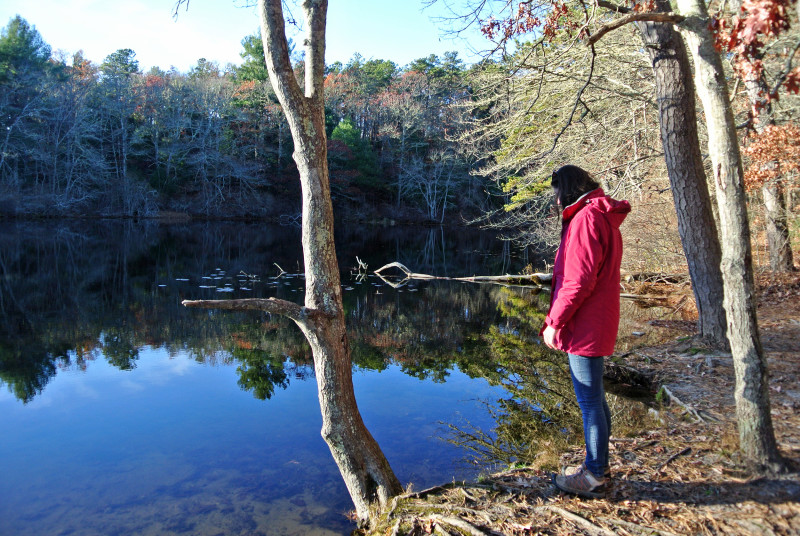
Enjoy the tranquil view of ponds at Four Ponds Conservation Area in Bourne.
At Four Ponds Conservation Area in Bourne, you can explore a variety of ponds, wetlands, and pines from the trails that weave through this town-owned property and the neighboring Bourne Town Forest. The “four ponds” here are actually man-made – most likely dammed for an iron foundry in the early 1800s.
Old service roads weave through the forests and around the ponds, creating four trails of different lengths that everyone can appreciate. When the ground is covered in snow, don’t despair: head to Four Ponds with a pair on snowshoes or cross-country skis for some winter fun!
11. Red Brook Pond Conservation Area (Bourne)
For a peaceful walk through classic Cape Cod scenery, head to Red Brook Pond Conservation Area in the Bourne village of Pocasset. With rolling trails through the woods, past working cranberry bogs, and along placid Red Brook Pond, this Bourne Conservation Trust property is an enjoyable place to explore any time of year.
For a quick jaunt down to Red Brook Pond, take the short loop trail from the parking area. There are several benches along the pond where you can sit, relax, and enjoy the view. Red Brook Pond is a particularly good place to watch for wintering waterfowl, including species like buffleheads, black ducks, and Canada geese.
12. Wing Pond Woods (Falmouth)
Peace and tranquility define secluded Wing Pond: a spawning area for river herring that migrate upstream from Herring Brook each spring. With a quaint old mill house by the edge of the pond and a working cranberry bog at its entrance, Wing Pond Woods has a classic Cape Cod feeling.
Freshwater ponds like Wing Pond are also a haven for ducks. Bring binoculars and watch for wildlife on the pond, and you may be rewarded with some exciting sights!
13. Breivogel Ponds Conservation Area (Falmouth)
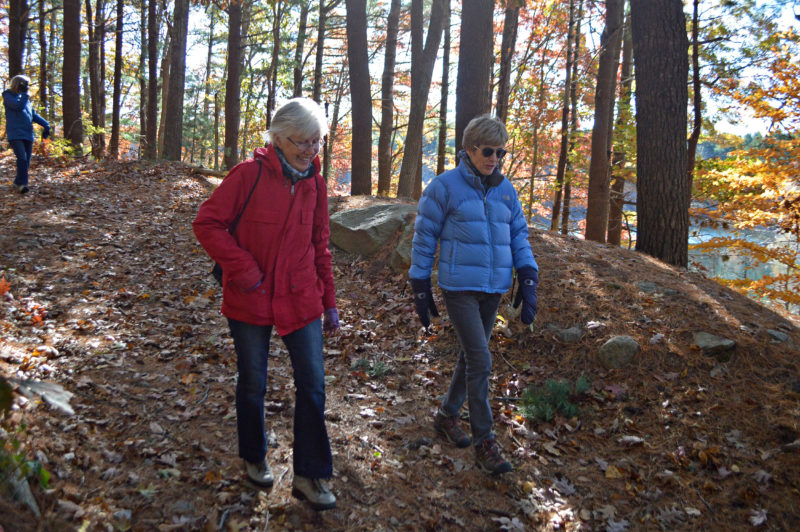
As you loop around Long Pond, there are some inclines that give you fantastic waterfront views.
Don’t be put off by the expanse of desert-like landscape at Breivogel Ponds Conservation Area in Falmouth. Once used as a sand and gravel operation, Breivogel now serves as critical habitat for native plants and animals.
The property features Shallow Pond, a vernal pool, and two man-made ponds surrounded by thick woods of tall pines. Follow the path from the old gravel road to reach the shores of Shallow Pond, where The 300 Committee is working to protect more woods in the area.
14. Long Pond (Falmouth)
A deep, elongated kettle hole, Long Pond has been Falmouth’s source of drinking water since the late 1800s. Today, Long Pond is protected by 585 acres of forest and swampland.
Although Long Pond itself is off-limits to the public, the area surrounding it is home to the Falmouth Moraine Trail, a 9-mile north-south route along the Falmouth moraine, created by glaciers during the last Ice Age. The Moraine Trail loops around Long Pond, with includes that give fantastic water views.